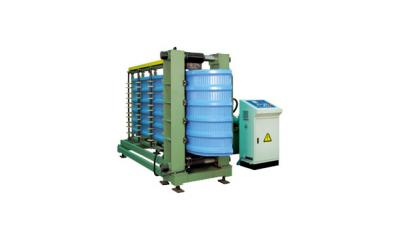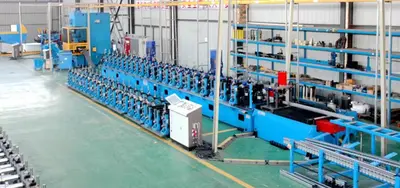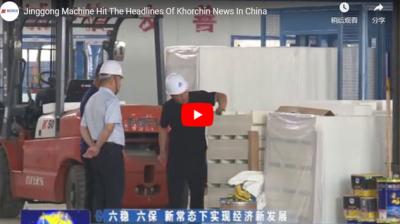Cold forming, also known as cold working or cold heading, is a metal shaping process that involves deforming metal at room temperature or slightly below its recrystallization temperature. Unlike hot forming methods that require high temperatures, cold forming relies on mechanical force to shape metal without heating it to a molten state. This process is commonly used for manufacturing fasteners, bolts, screws, and other precision metal components.
According to the different needs of users, the cold roll forming machine can match different parts to realize the cold bending processing of rail, I-beam, H-steel, iron and other materials. It has the advantages of high efficiency, easy transportation, convenient operation and so on.
The precision forming technology is used to replace the traditional cutting process. Because the internal gear of the reduction shaft has to bear great instantaneous bearing capacity, and at the same time, it also has to maintain the centering effect, so its coaxiality and mechanical strength are required to be higher, which makes the plastic forming more difficult, and effective process measures need to be taken.
According to the structural characteristics of the parts, the technological process of the reducer shaft is determined as follows: blanking → peeling → spheroidizing annealing → forward extrusion → upsetting → internal tooth forming → finished product.
The process of the cold roll forming machine is similar to the bending process, it is not a pure rolling process, but a special production method. The profile produced by this method has thin wall, light weight, high rigidity, complex shape and great length.
The main equipment of cold-formed profile production is cold forming unit, which has many kinds of classification methods. Forming machine can be divided into profile forming machine and welded pipe forming machine according to the products produced; cantilever forming machine and gantry forming machine according to the frame type; roller forming machine, row roller forming machine and crawler forming machine according to the forming mechanism.
The horizontal roll is the transmission frame, which undertakes the main task of tube blank deformation. The vertical roll is passive, which is set between two horizontal rolls or in groups. Its main function is to guide, participate in partial deformation and prevent the rebound of deformed strip.
In the production process of roll forming machines, when the metal strip passes through several pairs of rollers with pass in turn, the strip is fed forward with the rotation of the roller and is continuously bent at the same time, so as to obtain the parts with the required cross-section shape. It can be seen that roll forming is a continuous bending method.
Cold roll forming is a plastic processing method in which the whole length of the strip passes through several different passes in turn, the local part is gradually bent and deformed, the shape of the whole section is gradually close to that of the finished product, and finally, the product with uniform section is obtained. The pass is formed by the contour of two or more forming rolls (also known as rollers and rolls) with a certain shape. The forming rolls may be horizontal rolls or vertical rolls. Pass is one of the important factors affecting product quality and productivity.
The forming roll is installed on the frame. The forming roll which is responsible for driving the strip forward is driven by the motor through the transmission system. Generally, only the horizontal roll acts as the driving roll, and the vertical roll often acts as the passive roll. Each frame is called a forming machine, each forming machine is equipped with two or more forming rollers, and each forming unit is composed of more than two forming machines.
Advantages of Cold Roll Forming
Cold forming offers several advantages over other metal shaping methods:
Enhanced Strength: Cold formed components exhibit improved mechanical properties, such as higher tensile strength and hardness, due to the strain hardening effect during deformation.
Cost Efficiency: Cold forming eliminates the need for heating and subsequent cooling processes, reducing energy consumption and production costs.
Material Savings: The precise nature of cold forming minimizes material waste, resulting in significant material savings.
Surface Finish: Cold formed parts often have smooth surfaces and require minimal additional finishing operations.
High Production Rates: Cold forming machines can operate at high speeds, enabling the production of large quantities of components in a short time.
Metals for Cold Roll Forming
When it comes to choosing metals for cold roll forming, several factors need to be considered, including the material's ductility, strength, and formability. Here are some commonly used metals for cold roll forming:
Steel: Steel is the most widely used metal for cold roll forming due to its excellent strength, ductility, and formability. Different types of steel are available for various applications, such as carbon steel, stainless steel, and galvanized steel.
Aluminium: Aluminum is another popular choice for cold roll forming. It offers good formability, lightweight properties, and resistance to corrosion. Aluminium alloys, such as 3003 and 6061, are commonly used for cold roll-forming applications.
Copper: Copper possesses excellent conductivity and corrosion resistance. Although it is less commonly used for cold roll forming compared to steel and aluminium, it finds applications in industries where these properties are essential, such as electrical components and heat exchangers.
Brass: Brass, an alloy of copper and zinc, is sometimes used for cold roll forming. It offers good formability, corrosion resistance, and an attractive appearance, making it suitable for decorative and architectural applications.
Stainless Steel: Stainless steel is highly resistant to corrosion and oxidation, making it suitable for applications that require durability and hygiene. It is commonly used in industries such as food processing, automotive, and construction.


 CN
CN
 EN
EN
 fr
fr  de
de  es
es  it
it  ru
ru  pt
pt  ar
ar  th
th  pl
pl  ro
ro 







 Call us on:
Call us on:  Email Us:
Email Us:  #1809, Jianhu Rd, Keqiao, Shaoxing, Zhejiang, China
#1809, Jianhu Rd, Keqiao, Shaoxing, Zhejiang, China 